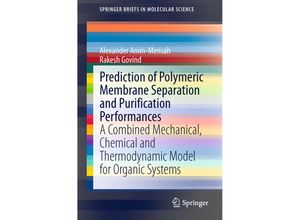This brief describes the development of a new model for realistically characterizing
solution-diffusion transport mechanisms in polymeric membranes that are used for separation and
purification of organic solvents. Polymeric membranes used in these environments if not
selected appropriately undergo excessive swelling and compaction resulting in lowered
performance or membrane destruction in the long-term. This brief describes the relationship
between key parameters from a chemical mechanical and thermodynamic perspective. Moreover the
authors show how this new model points membrane manufacturers scientists and engineers
towards an understanding of how these key parameters are considered in (1) designing and
manufacturing membranes for the right application (2) designing the right test experiments to
determine the long-term membrane behavior in a short time (3) minimizing the number of
experiments to determine a reliable membrane for an application and (4) selecting the right
membrane with higher level of certainty. The overall benefits of the model includes saving
money and time. A simplified version of the model is included to assist the reader.

